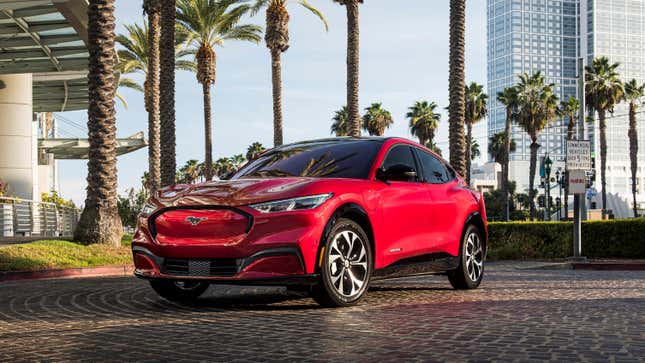
Ford hasn’t made it a secret that it has struggled to produce and sell electric vehicles at a profit. Earlier this year, the venerable automaker estimated that it will lose $3 billion on its electric vehicle division in 2023. Ford announced last week that it would reduce EV production to intentionally reduce supply to match demand because their vehicles are too expensive for their potential customers. However, The American Prospect argued against Ford’s direction, stating America’s underpaid workforce is more of the problem, while also untangling the myth surrounding Ford’s high wages during the Model T’s production.
First, the argument that electric vehicles are more expensive than comparable combustion cars is somewhat exaggerated. The issue large stems from the decision to electrify only the most profitable and physically largest models. For Ford, that would be the F-150 Lightning and the Mustang Mach-E. The Mach-E attaching the Mustang nameplate to a crossover SUV-sized vehicle.
It is true that electric cars, with their battery packs filled with hard-to-source minerals, are expensive, around $55,000 on average according to Kelley Blue Book. But that’s not far from the average price of any new car, which is now close to $50,000. The big problem for EVs from a price standpoint is that the whole industry has decided that the only way to cater to American tastes is to make their EV fleet out of trucks and SUVs, eliminating the economical sedans that might be affordable.
Ford’s decision to reduce EV production starkly contrasts the widely perpetuated mythology surrounding the company’s history. Most people have heard how Henry Ford paid his workers well so they could afford to buy the Model Ts they built. It is a myth that was a byproduct of a worker retention scheme meant to keep Ford’s relentless assembly lines staffed.
As myth would have it, Ford raised the wage because he understood that his cars needed buyers, and by setting the standard for decently paid production workers, he was giving the working class the ability to purchase his Model Ts. The history is a bit more nuanced: Ford had to be persuaded by his fellow executives to raise wages, not to create buyers but to hold on to his employees. Conditions of work on the early assembly lines were brutal (see, e.g., Charlie Chaplin’s Modern Times), and the turnover rate at the early Ford factories was stratospheric. Ford didn’t consider slowing down the lines, but he did reconsider his pay rates, and by raising them well above the current norm, he managed to stanch the one-way flow of Ford workers though the factory exits. (This same policy is alive and perniciously well at Amazon today, which attracts its warehouse workforce by paying more than local competitors but retains a Modern Times-esque pace of work.)
Ford and the country’s other two major automakers came into conflict with their workers when they organized in the following decades. The contracts with the United Auto Workers raised wages, included annual cost-of-living adjustments and bonus ties to the company’s productivity. The agreements created an unprecedented shared prosperity that helped forge the idealized image of post-WWII America.
The Big Three might have come into conflict with the UAW again. While Ford’s electric vehicle division is losing money, Detroit’s automakers are still seeing profits in the range of billions of dollars. Growing societal inequality has now impacted what would have been Ford’s primary customer base in prior decades, and the manufacturers could face another reckoning in the near future.
Ford’s announcement last Thursday also came at the same time that the UAW, now under new and apparently more militant leadership, is entering into talks with the Big Three auto companies (Ford, GM, and Stellantis) for its new contracts. The UAW spent last week highlighting the Big Three’s record profit announcements: $1.9 billion for Ford in the second quarter (triple that of a year earlier), $3.2 billion for GM in the second quarter (a 39 percent increase), and $12.1 billion for Stellantis in the first half of 2023 (an all-time high).
One among the many ways that the new UAW leadership is preparing its members for possible strikes is by using social media to show scenes from its militant past, enabling its members to witness how the Walter Reuther–led social democratic UAW of the mid-20th century walked picket lines for many months to win the kind of contracts that created the uncommonly widespread prosperity of that time.
The entire piece is worth a read, especially if you’re an executive at a Big Three automaker. It is a stark illustration of how we are at a crucial point where employee-worker relations could shape the direction of the country’s economy as it has done in the past.